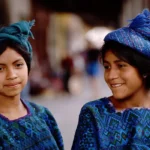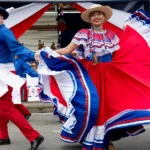Senegal, a country known for its lively music, dance, and art, also boasts a rich tradition of clothing that reflects its cultural diversity and history.
From the flowing boubous to intricate embroidery and bold fabrics, traditional Senegalese attire is as vibrant and varied as the people who wear it. Rooted in African, Islamic, and colonial influences, these garments serve as both practical attire and symbols of identity and pride.
Historical Roots of Senegalese Traditional Clothing
Pre-Colonial Era
In pre-colonial times, Senegalese clothing was primarily made from locally woven fabrics. Early garments were practical, reflecting the hot climate and local materials:
- Woven Cotton: Locally sourced and handwoven into simple, breathable garments.
- Animal Skins: Occasionally used by certain communities for durability and ceremonial purposes.
- Natural Dyes: Made from plants, clay, and minerals, providing vibrant hues.
Islamic Influence
The introduction of Islam in the 11th century had a profound impact on Senegalese clothing:
See also Traditional Clothing in Guatemala: A Vibrant Cultural Legacy
Traditional Clothing in Guatemala: A Vibrant Cultural Legacy
- Modesty: Loose-fitting garments like the boubou and kaftan became widespread.
- Head Coverings: Women adopted scarves and veils, often adorned with decorative elements.
Colonial Era
French colonization introduced new fabrics and tailoring techniques:
- Wax Prints: Originally brought by Dutch traders, these colorful fabrics became a staple in Senegalese fashion.
- European Silhouettes: Influenced formal wear, blending with traditional styles.
Key Elements of Senegalese Traditional Clothing
For Women
- Boubou (Grand Boubou):
- 👗 A long, flowing gown made of richly patterned fabric.
- Often paired with a matching moussor (headwrap).
- Pagne:
- 🧵 A versatile piece of fabric used as a wraparound skirt or head covering.
- Worn daily or during special occasions.
- Wax Print Fabrics:
- 🌺 Known for bold colors and intricate patterns.
- Commonly used for dresses, skirts, and matching sets.
- Jewelry and Accessories:
- 💎 Women wear gold or silver jewelry, including earrings, bracelets, and necklaces, to complement their attire.
For Men
- Boubou:
- 🧥 A wide, flowing robe worn over a tunic and trousers.
- Made from high-quality fabrics like cotton, silk, or brocade.
- Kaftan:
- 🕌 A long tunic-style garment, often embroidered around the neckline and cuffs.
- Worn for religious events and formal occasions.
- Headgear:
- 🎩 Men often wear a kufi (cap) or turban, reflecting Islamic traditions.
- Leather Sandals:
- 🥿 Comfortable and durable, these sandals are a staple in traditional men’s attire.
Regional Variations in Traditional Clothing
Wolof Community
The Wolof, Senegal’s largest ethnic group, have distinct clothing styles:
- Grand Boubous: Men and women wear intricately embroidered versions during weddings and religious ceremonies.
- Beaded Jewelry: Women adorn themselves with handcrafted beadwork symbolizing status and beauty.
Fulani People
Known for their nomadic lifestyle, the Fulani incorporate practicality into their attire:
- Indigo-Dyed Fabrics: Common in dresses and turbans, reflecting their affinity for natural dyes.
- Silver Accessories: Bracelets and necklaces often feature intricate designs.
Serer Community
The Serer people emphasize symbolic elements in their clothing:
See also Traditional Clothing in Costa Rica: A Vibrant Expression of Culture
Traditional Clothing in Costa Rica: A Vibrant Expression of Culture
- Handwoven Textiles: Featuring patterns that denote family lineage or social status.
- Cowrie Shell Adornments: Used in accessories for ceremonial purposes.
Casamance Region
The lush southern region of Casamance showcases vibrant and colorful attire:
- Bright Wax Prints: Popular for skirts and blouses among women.
- Leaf and Fiber Decorations: Occasionally incorporated into ceremonial clothing.
Cultural Significance of Traditional Clothing in Senegal
Religious Celebrations
Islamic holidays like Eid al-Fitr and Eid al-Adha see Senegalese people dressed in their finest traditional clothing. Men wear embroidered kaftans, while women showcase elaborate boubous paired with gold jewelry.
Weddings and Special Events
Traditional weddings are a showcase of Senegalese fashion:
- Bride’s Attire: A richly embroidered boubou with matching headwrap and veil.
- Groom’s Attire: A grand boubou or kaftan, often custom-tailored.
- Family Coordination: Relatives often wear matching fabrics to signify unity.
Artisan Craftsmanship
Senegalese clothing is celebrated for its meticulous craftsmanship:
- 🧶 Embroidery: Designs range from simple to intricate, showcasing the skill of local artisans.
- Hand-Dyeing: Techniques like batik and tie-dye create unique patterns.
- Tailoring: Skilled tailors ensure a perfect fit and high-quality finishes.
Challenges and Modern Adaptations
Globalization
Western-style clothing dominates urban areas, but traditional attire remains significant for cultural and religious events.
Fashion Innovation
Modern Senegalese designers are blending traditional elements with contemporary styles:
- Ankara Dresses: Combining wax print fabrics with modern cuts.
- Streetwear Fusion: Incorporating traditional patterns into casual wear.
- Jewelry Revival: Revitalizing ancient designs with a modern twist.
Preservation of Senegalese Traditional Clothing
Efforts to maintain and celebrate traditional clothing include:
- Cultural Festivals: Events like the Dakar Fashion Week and Saint-Louis Jazz Festival promote traditional styles.
- Educational Programs: Workshops teach weaving, dyeing, and embroidery techniques to younger generations.
- Museum Exhibitions: Institutions like the Musée de la Civilisation Noire showcase traditional attire.
The Enduring Legacy of Senegalese Traditional Clothing
Traditional clothing in Senegal is more than a celebration of beauty; it’s a statement of identity, heritage, and pride. Whether it’s the flowing boubou, the vibrant wax prints, or the intricate embroidery, each piece tells a story of cultural resilience and artistic excellence.
As Senegalese people continue to embrace their traditions while innovating for the future, their clothing remains a powerful symbol of the nation’s rich cultural tapestry.